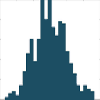
In doing the data analysis in my own research work, I was often slowed down by two things: 1) I did not know enough statistics, and 2) the books available would provide a theoretical background, but no real practical help. The book you are holding in your hands (or on your tablet or laptop) is intended to be the book that would have solved just this problem. It should provide enough basic understanding so you know what you are doing; and it should provide you with the tools to do so. In providing statistical solutions for the most basic statistical problem, I believe that I cover at least 90% of the problems that most physicists, biologists, and medical doctors encounter in their work. So if you are the typical graduate student working on your degree, chances are that you will find the solution - explanation and source-code - here. For serious statical work, you will need to dig into the serious statistics books and literature, which goes beyond the scope of this book, and - to be frank - beyond my statistical knowledge.
My motivation to provide the solutions in Python are based on two considerations. One is that I would like them to be available to everyone. While commercial solutions like Matlab, SPSS, Minitab etc. are available, most of us can only use them legally as long as they are in academia. In contrast, Python is completely free, as in “free beer” The second reason is that Python is the most beautiful coding language that I have yet encountered; and around 2010 Python and its documentation had matured to the point where you could use it without being a hacker. All together, you get a free, beautiful package that allows you to do all the statistics that at least 95% of all researchers need to do in their lifetime. OK, for really serious statistical modeling :math:`R` still sets the standard. But most of us will be more than happy with the tools that the Python ecosystem offers today.
For whom this book is¶
This book assumes that
- you have some basic programming experience (If you have zero prior programming experience, you may want to start out with getting going with Python, using some of the great links given in the text. Starting programming and starting statistics may be a bit much at a time.)
- you have some data that you want to analyze (For almost all cases, a working Python program is provided. All you have to do is select the right program, adjust it so that it reads in your data, and interpret the results.)
- that you are not a statistics expert (If you are already a statistics expert, the online help in Python will be sufficient to allow you to do most of your data anlysis right away.)
The idea of this book is to give you all (or at least most of) the tools that you will need for your statistical data analysis. Thereby I try to provide all the background required to understand what you are doing. I will not proof any theorems, and won’t indulge in mathematics where it is unnecessary. This approach explains why so much code is included: in principle, you have to define our problem, select the corresponding program, and adapt it to your needs. This should allow you to get going quickly, even if you have little Python experience. This is also the reason why I have not provided the software as a Python module, since I expect that you have to tailor each program to your specific setup (data format, etc).
How to use this book¶
If you just want to look something up, simply go to the HTML-version of the book.
In the online version, code samples are marked as follows
If you want to go through it systematically, or if you prefer to read printed material, you may want to download the PDF-version of the book.
The github repository of the book, which includes all the Python programs (PY and IPYNB-files), the sample data used in the book, and all the images.
If you have never used github, you might want to check out this introduction to github. But don’t be scared off, you can download individual files easily from your web-browser.
- Chapter 1
- gives an introduction to the book, especially to the Python programming environment that we are going to use.
- Chapter 2
- deals with reading data from different sources into Python.
- Chapter 3
- shows how to display data in Python, and gives some tips on experimental design.
- Chapter 4
- provides the basis on which statistic rests: continuous and discrete distribution functions.
- Chapter 5
- introduces the statistical basics: hypothesis tests, p-values, type I errors and type II errors, etc.
- Chapters 6-9
- desribe the most common hypothesis tests for univariate variables.
- Chapters 10
- gives an overview of Python tools for statistical modeling
- Chapters 11
- provides an introduction to correlation, regression analysis, and statistical modeling of bivariate data.
- Chapters 12
- shows how to deal with multivariate data.
- Chapters 13
- shows how to statistical modeling on categorical data (logistic regression).
- Chapters 14
- finishes with a presentation of the basic ideas of Bayesian Statistics.
Code samples are marked as follows
Python code samples, listed in the Appendix.
Contributor List¶
If you have a suggestion or correction, please send email to thomas.haslwanter@fh-linz.at. If I make a change based on your feedback, I will add you to the contributor list (unless you ask to be omitted).
If you include at least part of the sentence the error appears in, that makes it easy for me to search. Page and section numbers are fine, too, but not as easy to work with. Thanks!
- Connor Johnson wrote a very nice blog explaining the results of statsmodels OLS command, which formed the basis of a large part of the section on Statistical Models.
- To demonstrate Bayesian statistics and MCMC-models, I took the example of the Challenger disaster from the excellent open source e-book Probabilistic-Programming-and-Bayesian-Methods-for-Hackers by Cam Davidson Pilon.
- Fabian Pedregosa’s blog on ordinal logistic regression allowed me to include a topic that is admittedtly beyond my own skills.


